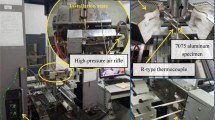Abstract
The 6xxx Al–Mg-Si heat-treatable alloy is lightweight, has good formability before baking-hardening, and enhanced strength after baking. The aluminum alloy is to replace steel in many automotive stamping sheet metal parts. However, under the normal hot rolling process, 6xxx aluminum alloy is prone to surface roping defects, owing to the uneven texture in the thickness direction. Aluminum with severe roping can also produce curling of the specimen in a uniaxial tensile test. The literature and related phenomena infer that the material thickness direction does not have a uniform r value. The r value measured by the test machine does not represent the actual whole r value of the material. Therefore, in this paper, the actual r values of the top and bottom surfaces of the material are derived from the geometry of the curl of the specimen. An alkali etching method is developed to layer the aluminum sheet’s thickness. The layer is used for tensile testing to verify the aluminum sheet’s actual r value and derive the difference in r value. Then, experiments and numerical simulations are used to show that the variation of thickness direction r is the leading cause of curl in the tensile specimen. Furthermore, the numerical simulation was used to evaluate the difference in r value of an aluminum sheet in each thickness layer and the effect of thickness layer on curl and then make a reasonable explanation and correction of the difference between the tensile test and simulation. Using this method can obtain a more accurate r value as the material parameter for each thickness direction of an aluminum sheet, which certainly improves the accuracy of numerical simulation and analysis for other forming processes.










Similar content being viewed by others
Availability of data and material
Not applicable.
Code availability
Not applicable.
References
Miller WS, Zhuang L, Bottema J, Wittebrood AJ, De Smet P, Haszler A, Vieregge A (2000) Recent development in aluminium alloys for the automotive industry. Mat Sci Eng A280:37–49. https://doi.org/10.1016/S0921-5093(99)00653-X
Yu Z, Lin Z, Zhao Y (2007) Evaluation of fracture limit in automotive aluminium alloy sheet forming. Mat Design 28203-207. https://doi.org/10.1016/j.matdes.2005.04.010
Jain M, Allin J, Lioyd DJ (1999) Fracture limit prediction using ductile fracture criteria for forming of an automotive aluminum sheet. Int J Mech Sci 411273-1288 https://doi.org/10.1016/S0020-7403(98)00070-8
Bhattacharya R, Stanton M, Dargue I, Williams G, Aylmore R (2010) Forming limit studies on different thickness aluminum 6xxx series alloy used in automotive applications. Int J Mater Form 3(Suppl 1):267–270. https://doi.org/10.1007/s12289-010-0758-4
Barnwal VK, Raghavan R, Tewari A, Narasimhan K, Mishra SK Effect of microstructure and texture on forming behaviour of AA-6061 aluminium Alloy Sheet. Mat Sci Eng https://doi.org/10.1016/j.msea.2016.10.027
Mishin OV, Bay B, Juul Jensen D (2000) Through-thickness texture gradients in cold-rolled. Metall Mater Trans A 31:A1653-1662. https://doi.org/10.1007/s11661-000-0175-2
Engler O, Hirsch J (2002) Texture control by thermomechanical processing of AA6xxx Al-Mg-Si sheet alloys for automotive applications-a review. Mat Sci Eng A336:249–262. https://doi.org/10.1016/S0921-5093(01)01968-2
Engler O, Huh MY, Tome CN (2000) A study of through-thickness texture gradients in rolled sheet. Metall Mater Trans 31A:2299–2315. https://doi.org/10.1007/s11661-000-0146-7
Bennett TA, Petrov RH, Kestens LAI (2009) Texture-induced surface roping in an automotive aluminium sheet. Scripta Mat 61:733–736. https://doi.org/10.1016/j.scriptamat.2009.06.016
Ghosh M, Miroux A, Kestens LAI (2015) Correlating r-value and through thickness texture in Al-Mg-Si alloy sheet. J Alloys Compd 619585-591. https://doi.org/10.1016/j.jallcom.2014.09.038
Schafer C, Brinkman H-J, Engler O, Nitzsche G, Keller S (2014) Methodology for quantification of the roping phenomena in 6xxx automotive car body sheet alloys. Mat Sci Forum 794–796:45–50. https://doi.org/10.4028/www.scientific.net/MSF.794-796.45
Inoue H, Yamasaki T, Gottstein G, Van Houtte P, Takasugi T (2005) Recrystallization texture and r-value of rolled and T4-treated Al-Mg-Si alloy sheet. Mat Sci Forum 495–497:573–578. https://doi.org/10.4028/www.scientific.net/MSF.495-497.573
Choi SH, Kim KH, Oh KH, Lee DN (1997) Tensile deformation behavior of stainless steel clad aluminum bilayer sheet. Mat Sci Eng A222158-165 https://doi.org/10.1016/S0921-5093(96)10514-1
Yan LZ, Zhang YA, Li XW, Li ZH, Huang SH, Wamg F, Liu HW, Xiong BQ, Zhao G (2015) Investigation of hot deformation on grain size and surface quality of 6016 aluminium alloy. Mat Res Innov 19:106–111. https://doi.org/10.1179/1432891715Z.0000000001525
Guillotin A, Guiglionda G, Maurice C, Driver JH (2010) An analysis of roping in AA6016 sheet by through-thickness texture measurements and numerical simulations. The Japan Institute of Light Metals 113–118. http://www.icaa-conference.net/ICAA12/pdf/1C-02.pdf
Guillotin A, Guiglionda G, Maurice C, Driver JH (2011) Correlation of surface roping with through-thickness microtextures in an AA6xxx sheet. Metall Mater Trans 42A:1919–1924. https://doi.org/10.1007/s11661-010-0601-z
Author information
Authors and Affiliations
Contributions
Conceptualization: Y.-M. H. and P.-S. C. Formal analysis: Y.-M. H. and P.-S. C. Experiments, P.-S. C. Writing—review and editing: Y.-M.H. All authors have read and agreed to the published version of the manuscript.
Corresponding author
Ethics declarations
Ethics approval
Not applicable.
Competing interests
The authors declare no competing interests.
Additional information
Publisher's Note
Springer Nature remains neutral with regard to jurisdictional claims in published maps and institutional affiliations.
Rights and permissions
Springer Nature or its licensor holds exclusive rights to this article under a publishing agreement with the author(s) or other rightsholder(s); author self-archiving of the accepted manuscript version of this article is solely governed by the terms of such publishing agreement and applicable law.
About this article
Cite this article
Hwang, YM., Chen, PS. Study of the curling of tensile test specimens from the 6xxx aluminum alloy sheet. Int J Adv Manuf Technol 122, 4191–4200 (2022). https://doi.org/10.1007/s00170-022-10168-5
Received:
Accepted:
Published:
Issue Date:
DOI: https://doi.org/10.1007/s00170-022-10168-5




